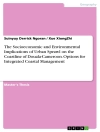This edited volume is an up-to-date guide for students, policy makers and engineers on earthquake engineering, including methods and technologies for seismic hazard detection and mitigation. The book was written in honour of the late Professor Jai Krishna, who was a pioneer in teaching and research in the field of earthquake engineering in India during his decades-long work at the University of Roorkee (now the Indian Institute of Technology Roorkee). The book comprehensively covers the historical development of earthquake engineering in India, and uses this background knowledge to address the need for current advances in earthquake engineering, especially in developing countries.
After discussing the history and growth of earthquake engineering in India from the past 50 years, the book addresses the present status of earthquake engineering in regards to the seismic resistant designs of bridges, buildings, railways, and other infrastructures. Specific topics include response spectrum superposition methods, design philosophy, system identification approaches, retaining walls, and shallow foundations. Readers will learn about developments in earthquake engineering over the past 50 years, and how new methods and technologies can be applied towards seismic risk and hazard identification and mitigation.
Tabela de Conteúdo
Part I: Engineering Seismology.- Chapter1. Engineering Seismology.- Chapter2. Developments in Seismological Instrumentation.- Chapter3. Strong Motion Instrumentation Programme in India. Chapter4. Strong Motion Studies.- Chapter5. New Regression Relations for Magnitude Conversion.- Chapter6. Tsunami Hazard Assessment.- Part 2: Geotechnical Earthquake Engineering.- Chapter7. Recent Developments in Liquefaction, stability analysis of retaining structures, shallow foundations and pile foundations.- Chapter8. Seismic Analysis and Design of Retaining Walls and Shallow Foundations.- Chapter9. Ground Improvement for Mitigating Liquefaction Hazard.- Chapter10. Recent Advances in Soil Dynamics.- Part 3: Structural Dynamics.- Chapter11. Developments in Earthquake Resistant Design of Bridges.- Chapter12. Developments in Earthquake Resistant Design of Reinforced Concrete Buildings.- Chapter13. Earthquake Resistant Design of Masonry Buildings.- Chapter14. Developments in Seismic Analysis and Displacement Based Design.- Chapter15. A Template for the Earthquake Resistant Design Code.- Chapter16. System Identification in Structural Dynamics.- Chapter17. A Review of the Response Spectrum Method.
Sobre o autor
Dr. M.L. Sharma is a Professor in the Department of Earthquake Engineering at the Indian Institute of Technology, Roorkee. He earned his Masters in Applied Geophysics and his Ph.D. in Earthquake Engineering from the University of Roorkee in 1985 and 1992 respectively. He has authored or co-authored 10 books and 82 journal articles, and is a member of several professional associations including the Indian Society of Engineering Geology, the Indian Geotechnical Society, and the Seismological Society of America. His research interests include engineering seismology, seismic microzonation, seismic hazard assessment, and strong ground motion prediction.
Dr. Manish Shrikhande is a Professor in the Department of Earthquake Engineering at the Indian Institute of Technology, Roorkee. He earned his Masters in Earthquake Engineering from the University of Roorkee in 1992, and his Ph.D. from the Institute of Technology, Kanpur in 1998. He has authored 3 books, 3 book chapters, and 22 journal articles, and is a member of the Indian Society of Earthquake Technology and the Earthquake Engineering Research Institute. His research interests include earthquake resistant design, engineering seismology, and seismic damage detection.
Dr. H.R. Wason is an Emeritus Fellow and former Professor in the Department of Earthquake Engineering at the Indian Institute of Technology, Roorkee. He is also the former President of the Indian Society of Earthquake Technology (ISET), and a member of several other professional societies including the Indian Geotechnical Society and the Indian Geological Congress. He has edited 1 book, 2 book chapters, and 32 journal articles, and 36 conference papers. His areas of specialization include engineering seismology, seismic hazard and risk assessment, microearthquake networks, and theoretical seismology.












